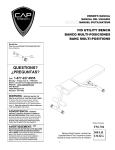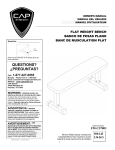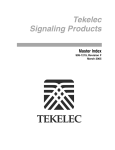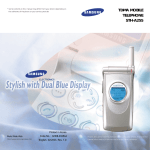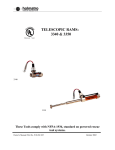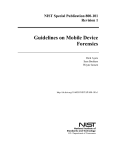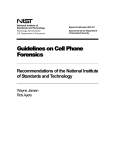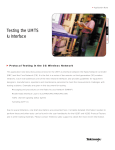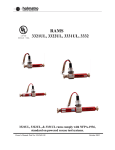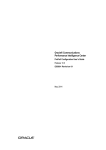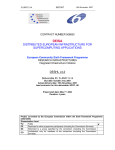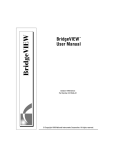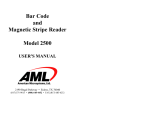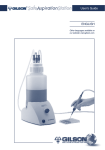Download Related Publications Reference
Transcript
Oracle® Communications EAGLE Related Publications Reference Release 46.2 E63610 Revision 1 July 2015 Oracle® Communications EAGLE Related Publications Reference, Release 46.2 Copyright © 1993, 2015, Oracle and/or its affiliates. All rights reserved. This software and related documentation are provided under a license agreement containing restrictions on use and disclosure and are protected by intellectual property laws. Except as expressly permitted in your license agreement or allowed by law, you may not use, copy, reproduce, translate, broadcast, modify, license, transmit, distribute, exhibit, perform, publish, or display any part, in any form, or by any means. Reverse engineering, disassembly, or decompilation of this software, unless required by law for interoperability, is prohibited. The information contained herein is subject to change without notice and is not warranted to be error-free. If you find any errors, please report them to us in writing. If this is software or related documentation that is delivered to the U.S. Government or anyone licensing it on behalf of the U.S. Government, then the following notice is applicable: U.S. GOVERNMENT END USERS: Oracle programs, including any operating system, integrated software, any programs installed on the hardware, and/or documentation, delivered to U.S. Government end users are "commercial computer software" pursuant to the applicable Federal Acquisition Regulation and agency-specific supplemental regulations. As such, use, duplication, disclosure, modification, and adaptation of the programs, including any operating system, integrated software, any programs installed on the hardware, and/or documentation, shall be subject to license terms and license restrictions applicable to the programs. No other rights are granted to the U.S. Government. This software or hardware is developed for general use in a variety of information management applications. It is not developed or intended for use in any inherently dangerous applications, including applications that may create a risk of personal injury. If you use this software or hardware in dangerous applications, then you shall be responsible to take all appropriate fail-safe, backup, redundancy, and other measures to ensure its safe use. Oracle Corporation and its affiliates disclaim any liability for any damages caused by use of this software or hardware in dangerous applications. Oracle and Java are registered trademarks of Oracle and/or its affiliates. Other names may be trademarks of their respective owners. Intel and Intel Xeon are trademarks or registered trademarks of Intel Corporation. All SPARC trademarks are used under license and are trademarks or registered trademarks of SPARC International, Inc. AMD, Opteron, the AMD logo, and the AMD Opteron logo are trademarks or registered trademarks of Advanced Micro Devices. UNIX is a registered trademark of The Open Group. This software or hardware and documentation may provide access to or information about content, products, and services from third parties. Oracle Corporation and its affiliates are not responsible for and expressly disclaim all warranties of any kind with respect to third-party content, products, and services unless otherwise set forth in an applicable agreement between you and Oracle. Oracle Corporation and its affiliates will not be responsible for any loss, costs, or damages incurred due to your access to or use of third-party content, products, or services, except as set forth in an applicable agreement between you and Oracle. Table of Contents Chapter 1: EAGLE Publications..................................................................4 Oracle Communications EAGLE Documentation.............................................................................5 Locate Product Documentation on the Oracle Help Center Site.....................................................9 Glossary...............................................................................................................................10 E63610 Revision 1, July 2015 iii Chapter 1 EAGLE Publications Topics: • • Oracle Communications EAGLE Documentation.....5 Locate Product Documentation on the Oracle Help Center Site.....9 E63610 Revision 1, July 2015 4 Related Publications EAGLE Publications Oracle Communications EAGLE Documentation Oracle Communications EAGLE customer documentation is a comprehensive group of electronic files available on the Customer Support site (see Locate Product Documentation on the Oracle Help Center Site). EAGLE Core Documentation • Release Notes describes the features contained in the specified release, including hardware baselines. It also contains Generic Program Loads (GPL)s, a list of PRs resolved in a build, the Product Compatibility Matrix, the EAGLE-PIC Compatibility Matrix, and the latest known PRs per system and subsystem. • Commands User's Guide contains procedures for logging in to or out of the EAGLE, a general description of the terminals, printers, the disk drive used, and a description of all the commands used in the system. • Commands Error Recovery Reference contains the procedures to resolve error message conditions generated by the commands in the Commands User's Guide. These error messages are presented in numerical order. • Database Administration – Features User's Guide contains procedural information required to configure the EAGLE to implement the STP LAN, Database Transport Access, GSM MAP Screening, and EAGLE Support for Integrated Sentinel features. • Database Administration - GWS User's Guide contains a description of the Gateway Screening (GWS) feature and the procedures necessary to configure the EAGLE to implement this feature. • Database Administration – GTT User's Guide contains procedural information required to configure an EAGLE to implement Global Title Translation features, including Enhanced Global Title Translation, Variable Length Global Title Translation, Interim Global Title Modification, Intermediate GTT Loadsharing, Flexible Intermediate GTT Loadsharing, Flexible Final GTT Loadsharing, ANSI/ITU SCCP Conversion, and Origin-Based SCCP Routing. • Database Administration - IP7 User's Guide contains procedural information required to configure the EAGLE to implement the SS7-IP Gateway. • Database Administration – SEAS User's Guide contains the EAGLE configuration procedures that can be performed from the Signaling Engineering and Administration Center (SEAC) or a Signaling Network Control Center (SNCC). Each procedure includes a brief description of the procedure, a flowchart showing the steps required, a list of any EAGLE commands that may be required for the procedure but that are not supported by SEAS, and a reference to optional procedure-related information, which can be found in the Database Administration manuals for either Gateway Screening, Global Title Translation, or SS7. • Database Administration – SS7 User's Guide contains procedural information required to configure an EAGLE to implement the SS7 protocol. • Database Administration – System Management User's Guide contains procedural information required to manage the EAGLE database and GPLs, and to configure basic system requirements such as user names and passwords, system-wide security requirements, and terminal configurations. • Measurements Reference contains descriptions of Basic OAM Measurements, the Measurements Platform, and E5-OAM Integrated Measurements. The measurements that can be collected, collection E63610 Revision 1, July 2015 5 Related Publications EAGLE Publications intervals, storage and retrieval of measurements, and the reports that can be generated for the EAGLE are described. • Unsolicited Alarm and Information Messages Reference describes the EAGLE system unsolicited alarm and information messages sent to the system terminal whenever there is a system fault, whenever a previous fault condition is corrected, or when a subsystem, equipment, and/or service is placed in or taken out-of-service. Each message has a trouble code and text associated with the trouble condition. • Security Guide describes how to ensure a secure installation of EAGLE and explains EAGLE security features. • System Healthcheck Guide describes the recommended methods and procedures to be used to evaluate Site and STP data retrieved from in-service EAGLE STPs. The scope of this document is specifically to collect data to determine the health of an in-service EAGLE prior to a software upgrade or an extension shelf installation. In general, this document may be used for an instance where the health determination of the EAGLE is required (i.e., troubleshooting). • Software Upgrade Guide describes methods utilized and procedures executed to perform a software upgrade on an in-service EAGLE STP. EAGLE Feature Documentation • Analyzed Information Features User's Guide provides information and instructions on how to configure, use, and maintain Analyzed Information features on the EAGLE. The Analyzed Information features are Info Analyzed Relay (IAR) Base, IAR Number Portability (IAR NP), IAR Additional Subscriber Data (IAR ASD), and IAR Generic Routing Number (IAR GRN). Service Portability and S-Port Subscriber Differentiation support for IAR NP are also described in the manual. • A-Port User's Guide describes a feature that provides the capability for IS41 mobile subscribers to change service provider while retaining their original Mobile Directory Number (MDN). This manual gives the instructions and information on how to configure, use, and maintain the A-Port feature on the EAGLE. • ATINP User's Guide describes a feature that provides the capability for IS41 subscribers to migrate to a GSM network and GSM mobile subscribers to migrate to an IS41 network. This manual provides instructions and information on how to configure, use, and maintain the IS41 GSM Migration (IGM) feature on the EAGLE. Service Portability support for ATINP is also described in the manual. • EIR User's Guide provides instructions and information on how to configure, use, and maintain the Equipment Identity Register (EIR) feature on the EAGLE. The feature provides network operators with the capability to prevent stolen or disallowed GSM mobile handsets from accessing the network. • ENUM User's Guide describes a feature that allows ENUM Number Portability Query messages to be received by an EAGLE ENUM card, processed by the database (RxDB, ENUM), and then a Tier 1 ENUM Response message pointing to a carrier Tier 2 server returned to the requestor. This manual provides feature descriptions, along with commands, maintenance, measurements, and configuration details associated with the ENUM Mobile Number Portability and Tier One Address Resolution feature. • G-Flex C7 Relay User's Guide describes features that support the efficient management of Home Location Registers in various networks. This manual provides instructions and information on E63610 Revision 1, July 2015 6 Related Publications EAGLE Publications how to configure, use, and maintain G-Flex,G-Flex MAP Layer EAGLE Routing, and EPAP Provisioning Blacklist features and theG-Flex Relay function on the EAGLE. • G-Port User's Guide describes features that provide the capability for mobile subscribers to change the GSM subscription network within a portability cluster while retaining their original MSISDNs. This manual provides instructions and information on how to configure, use, and maintain the G-Port, MT-based GSM SMS NP, MT-based GSM MMS NP, and GSM MAP SRI Redirect to Serving HLR, G-Port SRI Query for Prepaid, G-Port SCCP Service Re-Route Capability, and MNP Circular Route Prevention features on the EAGLE. Service Portability support for G-Port SRI Query for Prepaid is also described in the manual. • IDP-Related Features User's Guide provides information and instructions on how to configure, use, and maintain IDP-related features on the EAGLE. The IDP-related features are Prepaid IDP Query Relay (IDP Relay), IDP Screening for Prepaid, IDP A-Party Blacklist, and IDP A-Party Routing. Service Portability and S-Port Subscriber Differentiation support for IDP Relay are also described in the manual. • INP/AINPQ User's Guide describes the INP feature that provides INAP-based Number Portability functions and the AINPQ feature that provides ANSI-41 INP Query functions. This manual provides information and instructions on how to configure, use, and maintain the INP, AINPQ, and INP Circular Route Prevention features on the EAGLE. Service Portability support for INPQ and INPMR services and S-Port Subscriber Differentiation for the INPMR service are also described in the manual. • IS41 GSM Migration User's Guide describes a feature that provides the capability for IS41 subscribers to migrate to a GSM network and GSM mobile subscribers to migrate to an IS41 network and keep their original telephone number. This manual provides instructions and information on how to configure, use, and maintain the IS41 GSM Migration (IGM) feature on the EAGLE. • MO-SMS User's Guide addresses the number portability requirements of wireless network operators for delivery of Mobile Originated SMS messages in a number portability environment for GSM and IS41 and in the IS41-to-GSM Migration environment . The EAGLE MO SMS features apply number portability database lookup to SMS messages for IS41 and GSM networks. This manual provides instructions and information on how to configure, use, and maintain the MO-based GSM SMS NP, MO-based IS41 SMS NP, MO SMS IS41-to-GSM Migration, Portability Check for Mobile Originated SMS (MNP SMS), and Prepaid Short Message Service Intercept (PPSMS) features on the EAGLE. Service Portability and S-Port Subscriber Differentiation support for the MO-based GSM SMS NP and MO-based IS41 SMS NP features are also described in the manual. • Numbering Plan Processor (NPP) User's Guide describes a generic software process to provision complex numbering plans and to modify parameters for digit string filtering, conditioning, and encoding. NPP is used by EAGLE features; other manuals in this documentation set describe the specific use of NPP for a feature. The manual defines the components of NPP and their interactions, and describes a test tool that can be used to verify NPP provisioning before it is used with live traffic. • SIGTRAN User's Guide describes SS7-over-IP networks that use the Signaling Transport (SIGTRAN) protocol suite as an enabler to access IP networks. This document also examines reasons for transitioning, planning and dimensioning, and helpful information for implementing the network. • TIF User's Guide describes the functions and use of the Triggerless ISUP Framework (TIF) and the TIF Number Portability (TIF NP), TIF SCS Forwarding, and TIF Simple Number Substitution (TIF SNS) features. TIF provides a method for querying entities (such as gsmSCF) to obtain number portability and routing information for subscribers directly from an EAGLE acting as MNP SRF. E63610 Revision 1, July 2015 7 Related Publications EAGLE Publications The TIF NP feature uses TIF and NPP for incoming ISUP IAM message decoding, number conditioning, RTDB lookup for number portability information, and outgoing message formatting. The TIF SCS Forwarding feature determines when to use DTA to send relayed IAM and SAM MSU information to the SCS. The TIF SNS feature substitutes the calling party number in the ISUP IAM message with a single configured calling party number. The manual provides instructions and information about configuring and using TIF and the TIF features on the EAGLE. Service Portability support for TIF NP is also described in the manual. • V-Flex User's Guide describes the V-Flex Voice Mail Router (V-Flex) feature, which allows calls to be routed to a specific voice mail server (VMS) based on subscriber and call context data. This manual provides instructions and information on how to configure, use, and maintain the V-Flex Voice Mail Router (V-Flex) feature on the EAGLE. EAGLE Hardware, Installation and Maintenance Documentation • Hardware Reference provides an overview of each system and its subsystems, details of standard and optional hardware components in each system, and basic site engineering. Refer to this manual to obtain a basic understanding of each type of system and its related hardware, to locate detailed information about hardware components used in a particular release, and to help configure a site for use with the system hardware. • Installation Guide contains cabling requirements, schematics, and procedures for installing the EAGLE along with LEDs, connectors, cables, and power cords to peripherals. Refer to this manual to install components or the complete systems. • Maintenance Guide contains procedural information required for maintaining the EAGLE system. Maintenance Guide provides preventive maintenance procedures used in maintaining the different systems, including card removal and replacement procedures. • Application B Card Hardware and Installation Guide provides specifications and a description of the E5-APP-B card, as well as procedures for installation. Refer to this manual to obtain a basic understanding of the card, its hardware and installation requirements. Reference Documentation • Master Glossary contains an alphabetical listing of terms, acronyms, and abbreviations relevant to the system. • Previously Released Features summarizes the features of previous EAGLE releases, and it identifies the release number of their introduction. • Related Publications Reference (this document) lists all EAGLE-related documents. • Licensing Information User Manual is intended to help customers understand the program editions, entitlements, restrictions, prerequisites, and/or separately licensed third party technology terms associated with the EAGLE software. E63610 Revision 1, July 2015 8 Related Publications EAGLE Publications Locate Product Documentation on the Oracle Help Center Site Oracle Communications customer documentation is available on the web at the Oracle Help Center (OHC) site, http://docs.oracle.com. You do not have to register to access these documents. Viewing these files requires Adobe Acrobat Reader, which can be downloaded at http://www.adobe.com. 1. Access the Oracle Help Center site at http://docs.oracle.com. 2. Click Industries. 3. Under the Oracle Communications subheading, click the Oracle Communications documentation link. The Communications Documentation page appears. Most products covered by these documentation sets will appear under the headings “Network Session Delivery and Control Infrastructure” or “Platforms.” 4. Click on your Product and then the Release Number. A list of the entire documentation set for the selected product and release appears. 5. To download a file to your location, right-click the PDF link, select Save target as (or similar command based on your browser), and save to a local folder. E63610 Revision 1, July 2015 9 Glossary A ANSI American National Standards Institute An organization that administers and coordinates the U.S. voluntary standardization and conformity assessment system. ANSI develops and publishes standards. ANSI is a non-commercial, non-government organization which is funded by more than 1000 corporations, professional bodies, and enterprises. ATINP ATI Number Portability Query feature E EIR Equipment Identity Register A network entity used in GSM networks, as defined in the 3GPP Specifications for mobile networks. The entity stores lists of International Mobile Equipment Identity (IMEI) numbers, which correspond to physical handsets (not subscribers). Use of the EIR can prevent the use of stolen handsets because the network operator can enter the IMEI of these handsets into a 'blacklist' and prevent them from being registered on the network, thus making them useless. G G-Flex GSM Flexible numbering A feature that allows the operator to flexibly assign individual E63610 Revision 1, July 2015 10 Related Publications Glossary G subscribers across multiple HLRs and route signaling messages, based on subscriber numbering, accordingly. GPL Generic Program Load Software that allows the various features in the system to work. GPLs and applications are not the same software. GSM Global System for Mobile Communications A second generation digital PCS mobile phone standard used in many parts of the world. GWS Gateway Screening Used at gateway STPs to limit access into the network to authorized users. A gateway STP performs inter-network routing and gateway screening functions. GWS controls access to nonhome SS7 networks. Only an MSU that matches predefined criteria in the EAGLE database is allowed to enter the EAGLE. I Integrated Sentinel The Integrated Sentinel product provides monitoring capabilities for Signaling System 7 (SS7) links. Integrated Sentinel includes network surveillance capabilities and fault-management functions. IP Intelligent Peripheral Internet Protocol - IP specifies the format of packets, also called E63610 Revision 1, July 2015 11 Related Publications Glossary I datagrams, and the addressing scheme. The network layer for the TCP/IP protocol suite widely used on Ethernet networks, defined in STD 5, RFC 791. IP is a connectionless, best-effort packet switching protocol. It provides packet routing, fragmentation and re-assembly through the data link layer. ITU International Telecommunications Union An organization that operates worldwide to allow governments and the private telecommunications sector to coordinate the deployment and operating of telecommunications networks and services. The ITU is responsible for regulating, coordinating and developing international telecommunications, and for harmonizing national political interests. M MAP Mated Application Part Mobile Application Part An application part in SS7 signaling for mobile communications systems. N NPP Numbering Plan Processor Provides the flexible service application behavior that satisfies the needs of customers resident in complex signaling networks. It is used for number conditioning, RTDB lookup, and outgoing number formatting. P E63610 Revision 1, July 2015 12 Related Publications Glossary P PR Problem Report Tekelec’s term for a bug record. S SCCP Signaling Connection Control Part The signaling connection control part with additional functions for the Message Transfer Part (MTP) in SS7 signaling. Messages can be transmitted between arbitrary nodes in the signaling network using a connection-oriented or connectionless approach. SEAC Signaling Engineering and Administration Center SS7 Signaling System #7 A communications protocol that allows signaling points in a network to send messages to each other so that voice and data connections can be set up between these signaling points. These messages are sent over its own network and not over the revenue producing voice and data paths. The EAGLE is an STP, which is a device that routes these messages through the network. STP LAN Signaling Transfer Point Local Area Network. A feature in the EAGLE that copies MSUs selected through the gateway screening process and sends these MSUs over the Ethernet to an external host computer for further processing. E63610 Revision 1, July 2015 13













